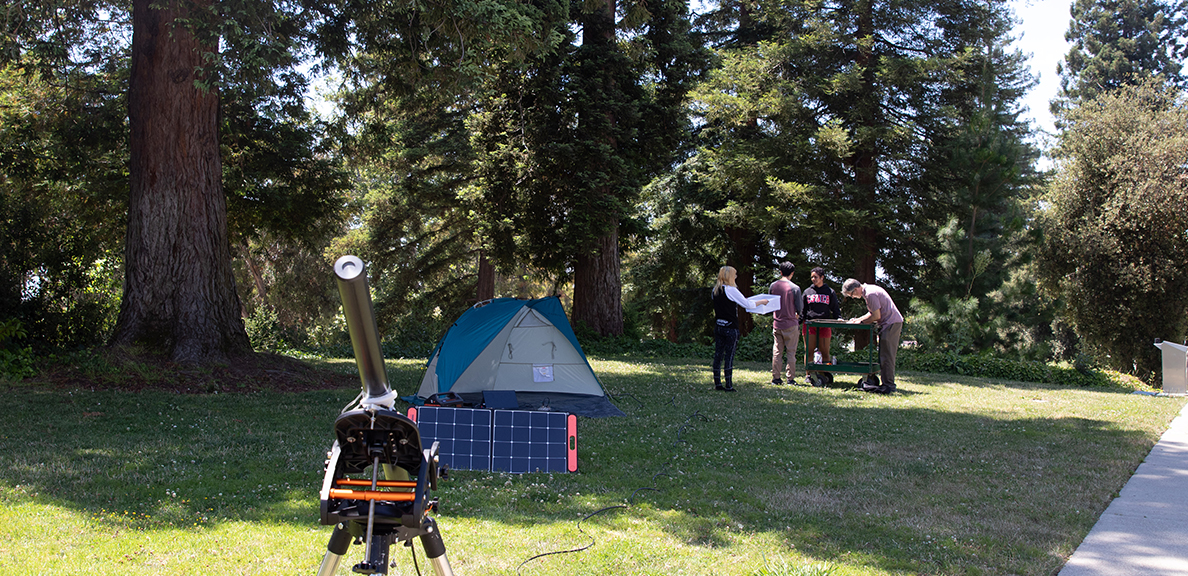
The Hunt for Dark Matter: One Wilderness Camping Trip at a Time
BY Kimberly Hawkins
November 27, 2023
Millions of Americans go camping every year, but a wilderness trip with Derek Jackson Kimball is far from typical. There are no s’mores, songs at the campfire or geocaching. Instead, there is scientific equipment, high-power detectors and a lot of note-taking as the Cal State East Bay physics professor and his students look for a substance of paramount importance to astrophysics, cosmology and particle physics.
“Dark matter is totally mysterious, we really have no idea what it is,” said Jackson Kimball. “It is always thrilling to explore the unknown because we don't know what we'll find and we can only guess what the broader implications might be if we found something!”
According to Jackson Kimball, we know about dark matter's existence because of its gravitational pull on stars and galaxies. The unknown invisible substance is thought to comprise about 85 percent of all matter in the universe. It does not absorb or emit light, which is radically different from atoms that make up stars, gas clouds and planets.
"The dark matter signature we are hunting for is a very feeble oscillating magnetic field. That's why we needed to take our sensors to a location in the wilderness far away from human-generated magnetic noise coming from sources like power lines and electronics," said Jackson Kimball.
The data collected from the camping trip this summer from Cal State East Bay, along with collaborators from Oberlin College and Bucknell University, showed no evidence of the oscillating magnetic field that would be generated if dark matter was made up of hypothetical particles known as axions or hidden photons. Jackson Kimball says that they can't rule out that dark matter is made up of axions or hidden photons, but they can rule out that it doesn't interact too strongly with known particles.
“Eliminating the possibilities is important in research,” said Brittany Karki (‘23 B.S, Physics). “The universe is vast. If we’re at a beach searching for a specific grain of sand, realistically most of our time will be spent eliminating the possibilities.”
Since science is born out of curiosity and wonder, the hunt for dark matter continues and the findings only ignite Jackson Kimball’s and his students' desire to keep discovering, ruling things out and putting other theories to the test.
“Our trip was an incredible experience, especially for me as a then first-year physics undergrad,” said Katie Hermanson, a Cal State East Bay physics student. “I had never imagined I would be camping with an amazing mentor/teacher and peers and colleagues all working together and collaborating for the fun of physics and research. As many research experiments take place indoors in a lab, this opportunity was special because we got to conduct our experiment outdoors in the beauty of nature.”
“It means a lot to create the opportunity for our students at Cal State East Bay to be involved in research that is at the cutting edge of science,” said Jackson Kimball. “The results of our search actually set the strongest experimental limits on hidden photon dark matter in the particle mass range we searched. So this is a meaningful experiment for the physics community, and our students played an absolutely essential role in making it happen: from designing and building the experiment to collecting the data in the wilderness to carrying out statistical analysis.”
The findings are published in a paper titled “Hunt for magnetic signatures of hidden-photon and axion dark matter in the wilderness" in Physical Review D. It has also been chosen as an Editor's Selection.
Jackson Kimball and his team of students are in the process of redesigning and improving both their detectors and experimental methodology.
“Early tests with our new setups show that we can improve our sensitivity to dark matter by more than a thousand times, and we can explore particle masses up to 200 times larger than what we did so far,” said Jackson Kimball. “That means our next search has a much better chance of finding out what dark matter might be! So we're getting ready to head out in the wilderness again.”
Share this story